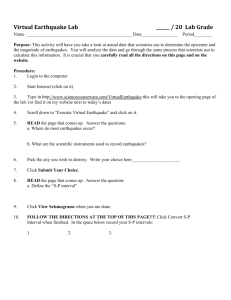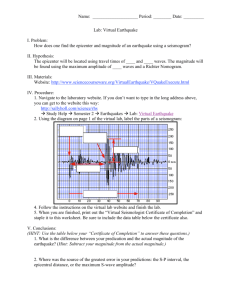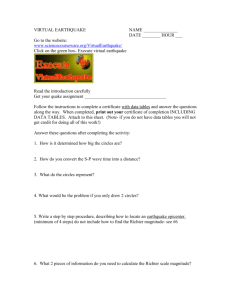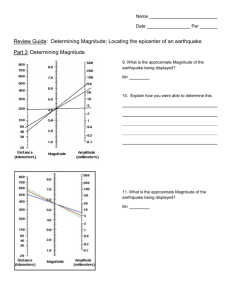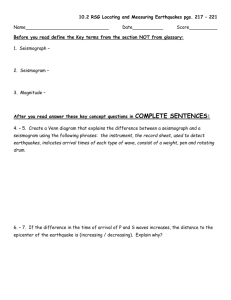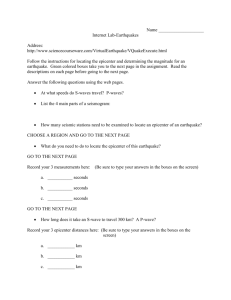VirtualEarthquake
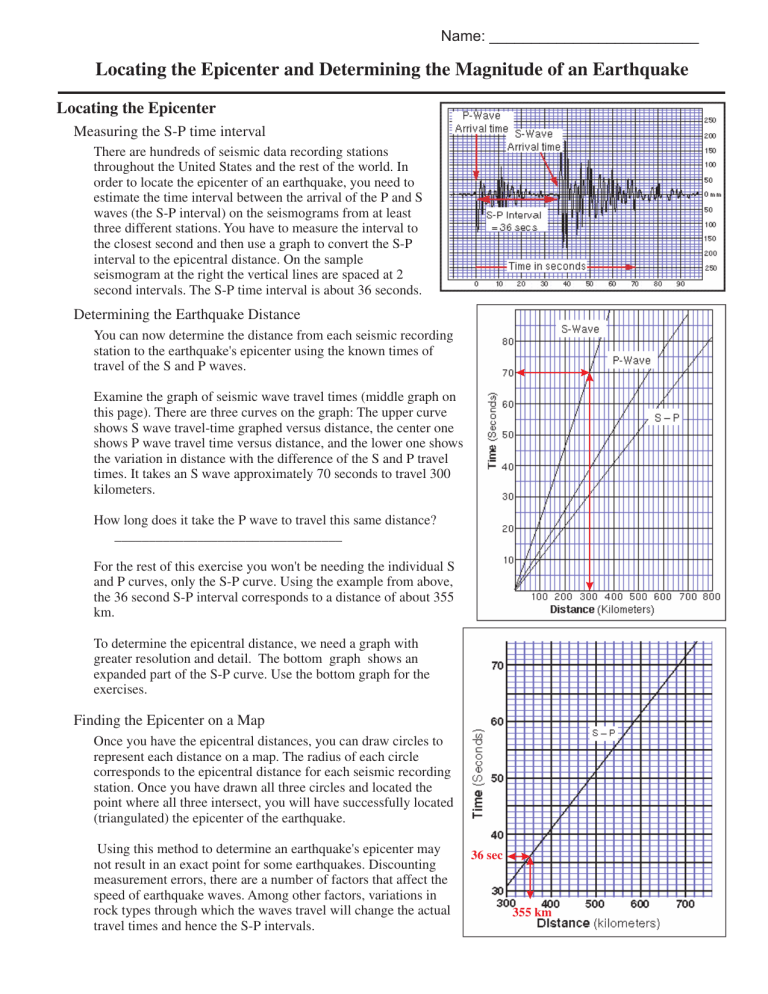
Name: _________________________
Locating the Epicenter and Determining the Magnitude of an Earthquake
Locating the Epicenter
Measuring the S-P time interval
There are hundreds of seismic data recording stations throughout the United States and the rest of the world. In order to locate the epicenter of an earthquake, you need to estimate the time interval between the arrival of the P and S waves (the S-P interval) on the seismograms from at least three different stations. You have to measure the interval to the closest second and then use a graph to convert the S-P interval to the epicentral distance. On the sample seismogram at the right the vertical lines are spaced at 2 second intervals. The S-P time interval is about 36 seconds.
Determining the Earthquake Distance
You can now determine the distance from each seismic recording station to the earthquake's epicenter using the known times of travel of the S and P waves.
Examine the graph of seismic wave travel times (middle graph on this page). There are three curves on the graph: The upper curve shows S wave travel-time graphed versus distance, the center one shows P wave travel time versus distance, and the lower one shows the variation in distance with the difference of the S and P travel times. It takes an S wave approximately 70 seconds to travel 300 kilometers.
How long does it take the P wave to travel this same distance?
_________________________________
For the rest of this exercise you won't be needing the individual S and P curves, only the S-P curve. Using the example from above, the 36 second S-P interval corresponds to a distance of about 355 km.
To determine the epicentral distance, we need a graph with greater resolution and detail. The bottom graph shows an expanded part of the S-P curve. Use the bottom graph for the exercises.
Finding the Epicenter on a Map
Once you have the epicentral distances, you can draw circles to represent each distance on a map. The radius of each circle corresponds to the epicentral distance for each seismic recording station. Once you have drawn all three circles and located the point where all three intersect, you will have successfully located
(triangulated) the epicenter of the earthquake.
Using this method to determine an earthquake's epicenter may not result in an exact point for some earthquakes. Discounting measurement errors, there are a number of factors that affect the speed of earthquake waves. Among other factors, variations in rock types through which the waves travel will change the actual travel times and hence the S-P intervals.
36 sec
355 km
The earthquake seismograms for this exercise are below
Eureka, CA seismograph station Elko, NV seismograph station
Time (seconds)
Las Vegas, NV seismograph station
Time (seconds)
Miles
0 100 200 400 600
0 100
Kilometers
200 300 400 500 600 700
Time (seconds)
Which seismogram shows the greatest amplitude?
__________________
Using just the amplitude, which seismograph station is probably closest to the epicenter?
(assume all three stations are located on bedrock.)
_____________
Complete the table below.
Use the seismograph recordings to determine the time interval between the arrival of the P- and Swaves. Next, use these time intervals and the bottom graph on page 1 to determine the distance from the epicenter for each seismograph station.
Station
S-P
Time Inteveral
Distance from
Epicenter
Eureka,
CA
Elko,
NV
Las Vegas
NV seconds seconds seconds
Km
Km
Km
The last step is drawing circles on the map to the left to represent the distance from the epicenter for each station. The radius of each circle should equal the corresponding distance from the epicenter. To know how large to draw each circle, use the scale on the map.
The location where all three circles overlap (or nearly overlap) is the location where the earthquake occurred.
Where is the epicenter? __________________
Page 2
Determining the Richter Magnitude
Magnitude Explained
So far you have worked on locating the epicenter of an earthquake. The next questions to ask are "How strong was this particular earthquake and how does it compare to other earthquakes?"
There are many ways that one could evaluate the relative strength of an earthquake: from the cost of repairs resulting from damage, from the length of rupture of the earthquake fault, from the amount of ground shaking, etc. But determining the strength of an earthquake using these kinds of "estimators" is full of potential problems and subjectivity. For example, the
Time (seconds) cost of repairs resulting from a strong earthquake in a remote region would be much less than that of a moderate earthquake in a populated area. Furthermore, the degree of damage would depend greatly on the quality of construction. Also, only a few earthquakes produce actual ground ruptures at the surface.
A well-known scale used to compare the strengths of earthquakes involves using the records (the seismograms) of an earthquake's shock waves. The scale, known as the Richter Magnitude Scale, was introduced into the science of seismology in 1935 by Dr. C. F. Richter of the California Institute of
Technology in Pasadena. The magnitude of an earthquake is an estimate of the total amount of energy released during fault rupture. The Richter magnitude of an earthquake is a number: about 3 for earthquakes that are strong enough for people to feel and about 8 for the Earth's strongest earthquakes. Although the
Richter scale has no upper nor lower limits, earthquakes greater than 9 in Richter magnitude are unlikely. The most sensitive seismographs can record nearby earthquakes with magnitude of about -2 which is the equivalent of stamping your foot on the floor.
D
C
The Richter magnitude determination is based on measurements made on seisograms. Two measurements are needed: the S-P time interval and the Maximum Amplitude of the Seismic waves. The illustration at the top right on this page shows how to make the measurement of the S wave's maximum amplitude. The blue horizontal grid lines are spaced at
10 millimeter intervals. In this example the maximum amplitude is about 185 mm.
B
A
The Richter Nomogram
Although the relationship between Richter magnitude and the measured amplitude and S-P interval is complex, a graphical device (a nomogram) can be used to simplify the process and to estimate magnitude from distance and amplitude.
In the diagram to the right, the horizontal dotted line (A) represents the "standard" Richter earthquake. This standard earthquake is 100 km away and produces 1 mm of amplitude on the seismogram. It is assigned a magnitude of 3. Other earthquakes can then be referenced to this standard.
Step 1: Mark the distance
Step 3: Draw a line and read off the magnitude
Step 2: Mark the amplitude
Page 3
The Richter Nomogram - continued
Note that a 100 km-away earthquake of magnitude 4 would produce 10 mm of amplitude (line B) and a magnitude 5 would produce 100 mm of amplitude
(line C) at the same distance. 1, 10 and 100 are all powers of 10 and this is why the Richter Scale is said to be "exponential." A change of one unit in magnitude (say from 4 to 5) increases the maximum amplitude by a factor of 10. The last line drawn, line
D, shows the result for an earthquake that produces an amplitude of 150 at a distance of 600 km.
Although only one amplitude measurement is necessary to estimate the magnitude of an earthquake, it is better to use measurements from several seismograph stations. This enables you to determine the magnitude value as an average of several values, thus increasing the likelihood that you are accurate in your estimate.
Complete the table below. First, copy the distances from page 2. Then use the seismograph recordings on page 2 to determine the maximum S-wave amplitude for each earthquake.
Station
Eureka,
CA
Elko,
NV
Las Vegas
NV
Distance from
Epicenter
Km
Km
Km
S-wave
Amplitude millimeters millimeters millimeters
Last, use the amplitude and distance data to draw a line for each seismograph recording on the nomogram below.
What is the magnitude of the earthquake?
________________________
Page 4
Station
Eureka,
CA
Elko,
NV
Las Vegas
NV
S-P
Time Inteveral
50 seconds
Distance from
Epicenter
485 Km
72
64 seconds seconds
705
622
Km
Km
S-wave
Amplitude
285 millimeters
60 millimeters
100 millimeters
Epicenter location: about 100 km SSE of San Francisco
Magnitude: about 7.1
1989 Loma Prieta earthquake
